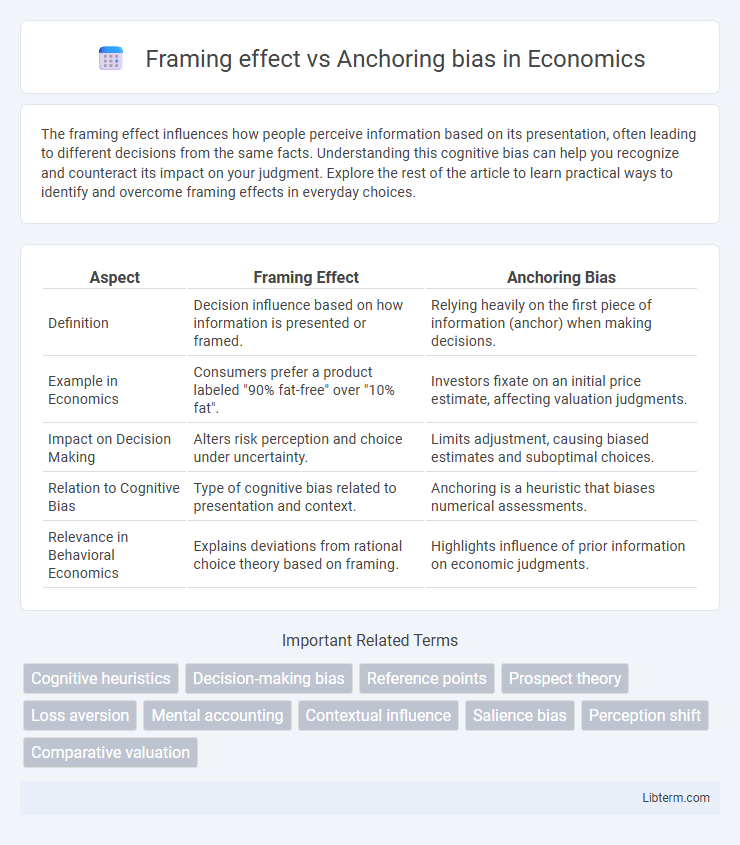The framing effect influences how people perceive information based on its presentation, often leading to different decisions from the same facts. Understanding this cognitive bias can help you recognize and counteract its impact on your judgment. Explore the rest of the article to learn practical ways to identify and overcome framing effects in everyday choices.
Table of Comparison
| Aspect | Framing Effect | Anchoring Bias |
|---|---|---|
| Definition | Decision influence based on how information is presented or framed. | Relying heavily on the first piece of information (anchor) when making decisions. |
| Example in Economics | Consumers prefer a product labeled "90% fat-free" over "10% fat". | Investors fixate on an initial price estimate, affecting valuation judgments. |
| Impact on Decision Making | Alters risk perception and choice under uncertainty. | Limits adjustment, causing biased estimates and suboptimal choices. |
| Relation to Cognitive Bias | Type of cognitive bias related to presentation and context. | Anchoring is a heuristic that biases numerical assessments. |
| Relevance in Behavioral Economics | Explains deviations from rational choice theory based on framing. | Highlights influence of prior information on economic judgments. |
Introduction to Cognitive Biases
Framing effect and anchoring bias are fundamental cognitive biases that influence decision-making processes by altering perception and judgment. Framing effect occurs when the way information is presented affects choices, while anchoring bias involves relying heavily on the first piece of information encountered. Both biases highlight the importance of cognitive heuristics in shaping human behavior and understanding these biases is crucial for improving critical thinking and decision accuracy.
Defining the Framing Effect
The framing effect refers to how people's choices and judgments are influenced by the way information is presented, rather than by the information itself. For example, describing a medical treatment as having a 90% survival rate versus a 10% mortality rate can lead to different decisions despite conveying identical statistics. This cognitive bias demonstrates that the context and wording used to frame options significantly impact decision-making processes.
Understanding Anchoring Bias
Anchoring bias occurs when individuals rely heavily on an initial piece of information, the "anchor," to make subsequent judgments or decisions, often leading to skewed outcomes. This cognitive bias affects various domains, including pricing, negotiations, and decision-making, where early exposure to numbers or suggestions unduly influences final assessments. Understanding anchoring bias helps improve critical thinking by encouraging reevaluation of initial anchors and seeking diverse information before concluding.
Key Differences Between Framing Effect and Anchoring Bias
Framing effect influences decision-making by altering perceptions based on how information is presented, such as highlighting gains versus losses, while anchoring bias involves relying heavily on the first piece of information encountered, which serves as a reference point for subsequent judgments. Framing effect alters choices by manipulating context or wording, whereas anchoring bias distorts estimates or evaluations due to initial exposure to a specific value or anchor. These cognitive biases differ in their mechanism: framing affects interpretation through presentation style, and anchoring impacts numerical or quantitative judgments anchored to early data.
How Framing Effect Influences Decision-Making
Framing effect influences decision-making by altering individuals' choices depending on how information is presented, often emphasizing positive or negative outcomes that sway perception and judgment. This cognitive bias causes people to react differently to the same data, leading to inconsistent decisions based on contextual framing rather than objective analysis. Understanding the framing effect helps in designing better communication and marketing strategies by strategically highlighting aspects that guide consumer behavior.
Impact of Anchoring Bias on Judgments
Anchoring bias significantly impacts judgments by causing individuals to rely heavily on the first piece of information encountered, which skews decision-making and estimation processes. This cognitive bias often leads to systematic errors in areas such as pricing, negotiation, and forecasting, where initial anchors unduly influence subsequent assessments. Research shows that even arbitrary or irrelevant anchors can distort judgments, highlighting the pervasive effect of anchoring in various cognitive tasks.
Real-World Examples: Framing vs Anchoring
Framing effect influences decision-making by presenting identical information in different ways, such as describing ground beef as "75% lean" versus "25% fat," leading to varying consumer preferences. Anchoring bias occurs when individuals rely heavily on an initial reference point, like a car's original price, which skews their perception of subsequent discounts or offers. In real-world contexts, marketers use framing to enhance product appeal, while negotiators exploit anchoring to set favorable terms.
Psychological Mechanisms Behind Both Biases
The framing effect arises from how information presentation influences decision-making by triggering emotional responses and shifting perception of risks and benefits. Anchoring bias occurs when individuals rely heavily on the first piece of information encountered (the anchor), which unconsciously skews subsequent judgments and adjustments. Both biases involve cognitive shortcuts rooted in heuristic processing, where the brain simplifies complex decisions by emphasizing initial cues or contextual framing.
Strategies to Reduce Framing and Anchoring Bias
To reduce framing effect, individuals can practice reframing problems by analyzing situations from multiple perspectives and explicitly considering alternative interpretations. Strategies to combat anchoring bias include deliberately seeking out information beyond the initial anchor and setting objective criteria for decision-making before evaluating options. Both biases diminish when decision-makers engage in reflective thinking and rely on diverse data rather than first impressions.
Conclusion: Why Recognizing These Biases Matters
Recognizing the framing effect and anchoring bias is crucial for making informed decisions and avoiding cognitive pitfalls that distort judgment. Awareness of these biases enhances critical thinking by promoting objective evaluation of information rather than reliance on initial impressions or presentation. This understanding leads to improved outcomes in fields such as finance, marketing, and negotiation by reducing errors influenced by biased perceptions.
Framing effect Infographic

 libterm.com
libterm.com